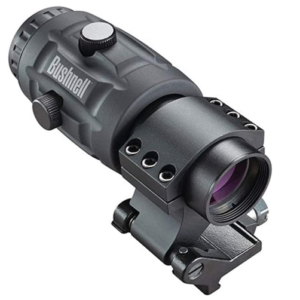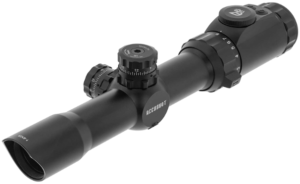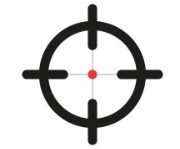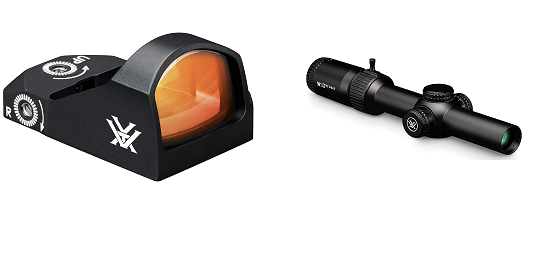Do you want to know whether a red dot magnifier or LVPO is better? In this post, we will highlight the important features, pros, and cons of red dot magnifiers and LVPOs. This will make it easy to find a reliable optic to enhance accuracy and precision shooting.
It is worth mentioning that red dot magnifiers and LVPOs (Low Power Variable Optic) have some similarities, but they have some key differences in design, compatibility, and performance. They also have different magnification levels.
If you are searching for a scope that offers a wide range of magnification, we recommend buying an LVPO scope. The magnification starts at 1x and can reach a maximum power range of 10x. This makes them suitable for engaging targets at close and long distances without sacrificing precision.
On the other hand, red dot magnifiers provide a quick and easy way to acquire close-range targets. You can attach magnifiers to the rear of a red dot sight to magnify the dot.
Let us compare red dot magnifiers and LVPO scopes to help you make an informed decision. It is advisable to define your requirements to make the selection process easy.
What is a Red Dot Magnifier?
 A red dot magnifier magnifies the dot of a red dot sight. It is attached to the rear end of a red dot sight to improve accuracy. This allows you to acquire targets at longer distances.
A red dot magnifier magnifies the dot of a red dot sight. It is attached to the rear end of a red dot sight to improve accuracy. This allows you to acquire targets at longer distances.
Law enforcement and military personnel commonly use them to hone accuracy skills. They are also ideal for target shooting or hunting applications.
However, a red dot magnifier should be paired with a red dot sight to acquire targets at close range. It uses an LED to project a red dot onto a reflector lens. They usually have a magnification of 2-3x magnification.
It is also important to consider the compatibility of the red dot magnifier. Not all red dot magnifiers are compatible with all red dot sights. Therefore, it is advisable to choose a model that is compatible with your red dot.
Let us look at the pros and cons of red dot magnifiers.
Pros
- They are very easy to use because you are not required to align crosshairs or adjust for windage and elevation. This makes it a suitable choice for beginners.
- The lightweight design makes it an excellent choice for heavy firearms.
- Red dot magnifiers are cheaper than Low Variable Power Optics.
- It allows you to switch between close and long-range engagements.
- It is ideal for hunting, target, or tactical shooting applications.
- There are many universal red dot magnifiers.
- It helps to improve target acquisition at close ranges.
Cons
- They have limited magnification, which might not be sufficient for long-range shooting applications.
- The magnifier can restrict the field of view, making it a bit challenging to acquire close-range targets.
- Not all red dot magnifiers are compatible with red dot sights.
What is an LVPO (Low Variable Optic)?
 A Low Variable Power Optic offers a wide range of magnification, usually 1-6x or 1-8x. They are specifically designed for engaging close to long-range shooting applications.
A Low Variable Power Optic offers a wide range of magnification, usually 1-6x or 1-8x. They are specifically designed for engaging close to long-range shooting applications.
LVPOs are better than red dots because they allow you to adjust the magnification level to match the target’s distance. They come with windage and elevation adjustments to improve precision. This is why they are commonly used for competitive shooting or hunting. They can also be used by law enforcement and military personnel.
LVPOs use a First Focal Plane reticle to make holdover and windage corrections across all magnification levels. In addition, they have a relatively wide field of view, allowing you to acquire targets at close ranges quickly.
Let us look at the pros and cons of LVPOs.
Pros
- They are ideal for close to long-range shooting applications.
- They provide high-quality images, making it easy to acquire targets even at high magnification levels.
- They are durable and long-lasting compared to red dot sights.
- They use a first focal plane reticle that allows you to make holdover and windage corrections across all magnification levels.
- They have a wide field of view that allows the shooter to acquire long-range targets.
- The reticle is illuminated, allowing you to use it in low-lighting conditions.
- Some options come with an adjustable objective lens that allows you to fine-tune the focus.
- They come with windage and elevation adjustments.
Cons
- They are more expensive than red dot magnifiers.
- They have limited eye relief.
- The magnification might not be enough for some long-range engagements.
Frequently Asked Questions on Red Dot Magnifier Vs LVPO
Here are some of the frequently asked questions on red dot magnifier vs LVPO:
- What is the difference between a red dot magnifier and an LVPO?
A red dot magnifier is attached to the rear of a red dot sight to magnify the dot. This allows you to engage targets at longer distances with more accuracy. An LVPO, on the other hand, is a variable power optic that offers a wide range of magnifications. The magnification is usually between 1-6x or 1-8x. This makes it easy to engage targets at close and long distances precisely.
- How does the weight of an LVPO compare to that of a red dot magnifier?
Most LVPOs available today are heavier and bulkier than red dot magnifiers. This makes them challenging to carry and handle, especially when hunting or target shooting. The bulkiness or weight is important to consider if you are planning to use your rifle for extended periods or in situations where weight and bulkiness are a concern.
- How much more expensive is an LVPO than a red dot magnifier?
LVPOs are generally more expensive than red dot magnifiers. However, the price difference can vary depending on the brand, features, and quality of the optic. Pick an optic that suits your specific needs and preferences.
- Are LVPOs more durable than red dot magnifiers?
LVPOs are constructed with high-quality materials, making them durable and long-lasting. However, the durability of an optic depends on how well it is maintained and how well it is protected from impact and other types of damage. However, there are many durable red dot magnifiers available on the market today.
- Are LVPOs used for close-range engagements?
Yes, an LVPO can be used for close-range engagements. This is because they have variable magnification, allowing you to hit targets at different ranges. It is also very easy to adjust the magnification level to match the target’s distance.
Conclusion
In conclusion, you have seen that red dot magnifiers and LVPOs are suitable for a wide range of shooting applications. Each has unique characteristics and advantages, making them ideal for those who prioritize speed and simplicity.
Before choosing any optic, it is advisable to consider your specific needs and preferences. This will make the selection process easy. It is also essential to consider the shooting you will be doing.
We recommend red dot magnifiers for close-range shooting engagements. On the other hand, LVPOs are ideal for long-range shooting applications.
We hope that this red dot magnifier vs LVPO helped you learn more about these optics. You can also check Red Dot Vs 1-6 Scope.

